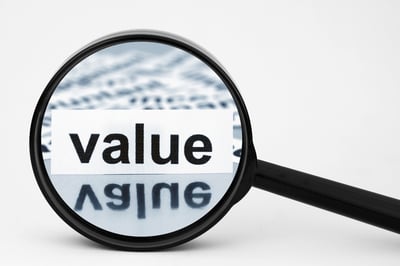 A theme throughout everything that I write is the need to create value in every aspect of a company's go-to-market strategy. Several comments that I've received to previous posts have made me realize I need to explain more what I mean when I say value. This is a brief version of an article I've written before.
A theme throughout everything that I write is the need to create value in every aspect of a company's go-to-market strategy. Several comments that I've received to previous posts have made me realize I need to explain more what I mean when I say value. This is a brief version of an article I've written before.
People define value in many ways. One of the best ways companies can differentiate themselves is to hone in on the unique value definitions each customer has. However, before you can hone in on a unique value definition effectively, you must understand that there are two value-segments into which your customers fall: fundamental value and total value. Fundamental value focuses exclusively on the product/service itself. Total value focuses on the product/service and potential areas of value beyond the product/service.
A fundamental-value customer would not be interested in the wisdom a salesperson, advisor, or company has developed. Fundamental-value buyers are only interested in the product or service; there is no additional value that can be offered to them. Moreover, fundamental-value buyers often feel they are qualified to discern the differences between options and to understand the implications of their decisions. They are not necessarily qualified to make those decisions, but that does not matter.
Total-value customers are different. They may be open to a company’s wisdom or insights. They may want to hear how they can apply solutions in a different manner. In addition to the value that lies within the product or service, total-value customers are interested in value-added offerings.
You must structure your sales effort so that it matches your customer’s value segment. In other words, you must align your sales model with your customer’s definition of value. When selling to fundamental-value customers, your focus should be on reducing the costs associated with buying. As I said, the maximum value you can provide to this customer is limited to the value that lies within the product or service. The only way to improve the cost/reward equation is to reduce the total cost of purchasing. This does not mean that you need to sell your product at the lowest price. It does mean you need to pay extra special attention to all the costs associated with purchases: hard and soft, direct and indirect. This can impact your sales process by reducing the interaction between salespeople and customers. Sometimes, it may mean eliminating your sales force altogether. Dell is perhaps the greatest practitioner of this concept in manufacturing. Travelocity applies this principle well in the services sector through their sale of airline tickets and vacations.
When dealing with total-value customers the focus should be on maximizing the reward, as well as controlling costs. With these customers you’ll want to focus on a value-added process; you can increase value independent of the product, enabling you to work on both the reward and cost side of the value equation.
No matter how hard you work or how much money you spend on marketing, a misaligned sales model will not work. When a sales organization emerges applies a sales model that does not align with the customer’s value segment failure awaits.

 Doug Davidoff
Doug Davidoff